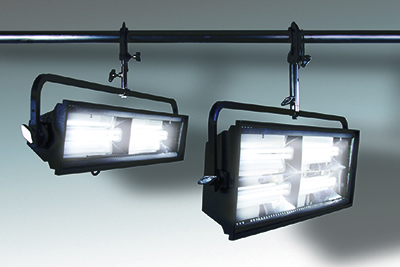Kino Flo Fluorescents Light the Way

KinoFlo ParaZip fluorescents SAN FRANCISCO—As a working lighting designer, the most common question I hear is, “Can we do this with LEDs?” For lighting today’s news sets, talk shows and other types of studio sets, the question might be better put as, “Do LEDs make sense for this project and/or studio?”
The term LED is certainly one of the hot buzz words at any lighting event or trade show, but are they really the right tool for every job?
LED PROS AND CONS
There are many positive attributes to a high-quality LED lighting fixture (such as the Kino Flo Celeb) including long lamp life, low-power consumption, good color rendering, DMX control, optional colorchanging fixtures, and more. However, there can also be some noteworthy drawbacks to many of the LED fixtures on the market today, such as low output, poor color rendering, uneven beam spread, and a lack of true soft light quality from an LED “soft light.” Perhaps more importantly, the cost of most quality LED fixtures can be quite high, and once the cost of an all- LED studio is considered, often the idea is thrown out.
I recently worked on a job involving the lighting of a news talk show set and it brought out many of the confusing issues surrounding the use of LED lights for studio work. The client had ordered a dozen or more 1×1 LED fixtures as part of their “green” effort in the news studio. Although the light from a 1×1 LED source is softer than from a Fresnel spot source, it’s far from true soft light—especially at a distance of eight to 12 feet. I’ve found that the Kino Flo Celeb is one of the few LED instruments that generates a true soft light. Most other LED panel sources need to be diffused in order to cast a more pleasing light on the talent.
Additionally, many news directors like the flexibility of having the talent look at several different camera positions, which can lead to unattractive shadows from smaller sources. This is exactly what happened with my client on this job, so I opted to change out the main light sources (the 1×1 LEDs) and use larger fluorescent fixtures—Kino Flo ParaZips—as my primary illumination sources for the set. The soft wrap of light from the ParaZips created a beautiful look on the talent and provided the flexibility of multiple camera angles without the worry of difficult shadows. The 1×1’s were then relegated to serve as small fill light sources throughout the set.
Another common misconception about LED lighting today centers on the lumens per dollar cost factor. With all factors considered, in most of my studio work, I still find that the high output and light quality from fixtures such as the Kino Flo 4-banks, ParaZips and ParaBeams are a much better choice for lighting the talent on a studio set. The softer light, low power consumption and long lamp life of a quality fluorescent fixture make such Kino Flo instruments an excellent longterm investment for studio operations.
Bill Holshevnikoff is a San Franciscobased DP/lighting designer. He has been lighting studio sets and location productions around the globe for the past 30 years. He may be contacted atbholshev@comcast.net.
The professional video industry's #1 source for news, trends and product and tech information. Sign up below.
For additional information, contact Kino Flo Lighting Systems at 818-767- 6528 or visitwww.kinoflo.com.
